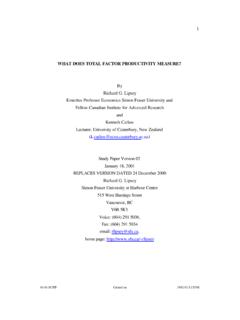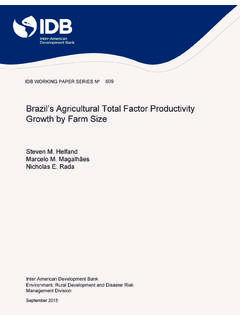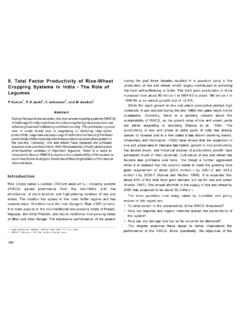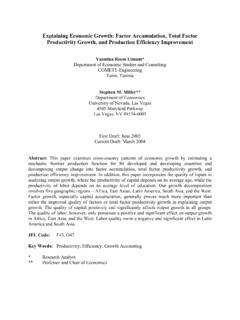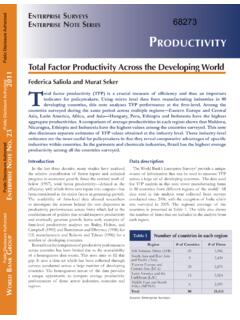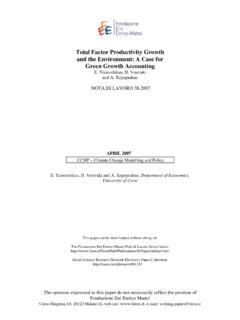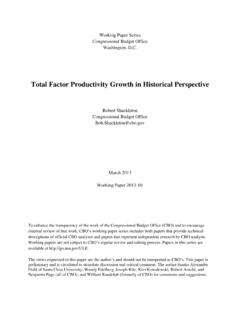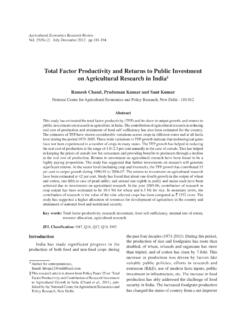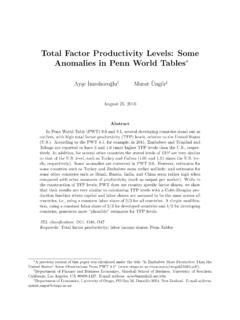Transcription of Explaining Total Factor Productivity Change in U.S ...
1 1 Explaining Total Factor Productivity Change in Agriculture: An Examination of Components By Darlington Sabasi* and C. Richard Shumway Darlington Sabasi is a Graduate Research Assistant, and C. Richard Shumway is a Regents Professor in the School of Economic Sciences, Washington State University, 101 Hulbert Hall, PO Box 646210, Pullman, WA 99163-6210. *Corresponding Author: e-mail: |Ph. 509-432-6973|Fax: 509-335-1173 Abstract Change in Total Factor Productivity can be decomposed into technical and efficiency Change measures. This paper examines factors driving three components of Total Factor Productivity Change in agriculture technical Change , technical efficiency Change , and scale and mix efficiency Change . We also examine Total Factor Productivity Change and contrast implications derived from the component models with those from a directly estimated Total Factor Productivity Change model. Our results show that technical Change is significantly impacted by innovation through public research and improved human capital through education and health care access.
2 Further, climate warming is beneficial to technical Change in the Central and Northern band of states but harmful in the warmer Southern band of states. Technical efficiency Change is affected by farm size, the ratio of family-to- Total labor, and environmental conditions including climate Change , while scale and mix efficiency Change is impacted by the ratio of family-to- Total labor, climate Change , and government policies. Similar to its impact on technical Change , the impact of climate warming on technical efficiency Change is heterogeneous across regions. Climate Change variables are the most impactful factors on each component as well as on Total Factor Productivity Change , and their estimated historical impact is most often positive. With few exceptions, Total Factor Productivity Change elasticities estimated directly are qualitatively the same as those calculated from the component models. Keywords: climate Change , scale and mix efficiency, technical Change , technical efficiency, Total Factor Productivity , agriculture JEL Classification: D24, Q16 _____ Acknowledgements: The authors thank Christopher J.
3 O Donnell, Michael J. Roberts, V. Eldon Ball, Wallace E. Huffman, and Yucan Liu for the data they provided. The authors also thank Christopher J. O Donnell, Hayley H. Chouinard, Jonathan K. Yoder, Sansi Yang, Tristan D. Skolrud, and Vine Mutyasira for helpful comments on earlier drafts. This project was supported by the Washington Agricultural Research Center and by the USDA National Institute of Food and Agriculture, Hatch grant WPN000275. 2 Explaining Total Factor Productivity Change in Agriculture: An Examination of Components Despite consistent growth in agricultural Total Factor Productivity (TFP) over the last century, evidence of a recent slowdown in Productivity growth has been documented (James et al. 2009; Alston et al. 2010, p. 110; Ball, Schimmelpfennig, and Wang 2013). Most alarming is the rate of slowdown. Agricultural Productivity growth grew at an average annual rate of percent from 1948 to 1974 (Ball, Schimmelpfennig, and Wang 2013) but only percent between 2000 and 2007 with a partial rebound to percent between 2007 and 2011 (Ball, Wang, and Nehring 2015).
4 Climate Change has been suggested as one possible explanation for this decline (Villavicencio et al. 2013). In light of the Productivity growth slowdown, understanding sources of TFP growth and how it can be sustained is important to ensure current and future food security, preserve the environment, mitigate the impacts of climate Change , and maintain the agricultural industry s competitiveness internationally. There exists a substantial research literature on TFP growth, and much of it has examined the responsiveness of TFP to factors such as public expenditures. For example, research and development (R&D) and education have been repeatedly documented as major factors that affect agricultural TFP ( , Ball et al. 1997; Alston, Craig and Pardey 1998; Ball et al. 1999; Makki, Tweeten and Thraen 1999; Huffman and Evenson 2006; Alston et al. 2011; Plastina and Fulginiti 2012). Yet there has been little consideration of additional human capital factors such as health status nor of resource or environmental conditions.
5 For example, although there is general consensus that the climate has been changing over the past century ( , Yang and Shumway 2015), only one study (Villavicencio et al. 2013), has examined the impact of weather on agricultural Productivity and drawn implications for the effects of climate Change . The Change in TFP (TFPC) is determined by both technical and efficiency Change , and TFPC can be exhaustively decomposed into technical and efficiency Change measures (Farrell 1957; 3 Capalbo 1988; F re et al. 1994; Balk 2001; Kuosmanen et al. 2009; Jin et al. 2010; O Donnell 2012). However, analysis of overall TFPC does not provide clear understanding of driving forces behind these individual components of TFPC, and little attention has been given to identifying factors that impact the components. Decomposition of TFPC into TC and efficiency Change components can provide more information on production technology and whether the technology is being used in a way that realizes its full potential.
6 These components can be illustrated by reference to the production frontier. The production frontier identifies the maximum output that can be produced from given inputs and technology. A shift (which results in a Change in the maximum possible TFP) in the production frontier over time is referred to as technical Change (TC) or technical progress. The ratio of actual production to production on the frontier is defined as technical efficiency (TE) (Farrell 1957). That is, any production not on the production frontier is technically inefficient production. Scale and mix efficiency (SME) measures movement around the production frontier to capture economies of scale in addition to movement from one production frontier for which the input and/or output mix is restricted to another production frontier with no restrictions on the mix to capture economies of scope (O Donnell 2012). The TFPC components ultimately determine TFP growth. Consequently, an examination of the factors that affect each component provides an important avenue for a more detailed understanding of the underlying forces impacting TFPC.
7 It may also provide more focused policy implications for surmounting the slowdown in TFP growth. We contribute to the Productivity literature in two ways. First, we systematically examine factors affecting all three TFPC components for aggregate agricultural production. Most prior studies on the drivers of TFPC components have focused on a single component. For example, Paris (2008), Ollinger, MacDonald, and Madison (2005), and Chavas, Aliber, and Cox (1997) examined factors affecting TC, Key and Sneeringer (2014), Mayen, Balagtas, and Alexander (2010), and 4 Kalirajan (1991) examined TE, and Paul et al. (2004) and Mosheim and Lovell (2009) examined SMEC in agriculture. But none examined all three components. We use O Donnell s (2012) exhaustive decomposition of TFPC into measures of TC, TEC, and SMEC based on state-level panel data for the period 1960-2004. Second, we examine the impact of potentially important variables that have not generally been included in prior research to explain TFPC or the components.
8 They include the effect of health care access as well as resource and environmental conditions. Results show that climate Change has the largest impact on TFPC and on each of its components. Its impact, however, is heterogeneous both among components and across groups of states. Health care access is an important Factor affecting both TC and TFPC, terms of trade affects TC, farm size affects TEC, the family-to- Total labor ratio affects TEC, SMEC, and TFPC, current year precipitation is important to TC, TEC, and TFPC, and damaging degree days (a measure of adverse current year temperature) affects TEC and TFPC in the Central band of states. Our results provide strong evidence that failure to include these or similar variables in agricultural Productivity analysis may result in omitted variable bias. In addition, consistent with previous literature, within-state public research and spill-in from neighboring states impact TC and TFPC, education impacts TC, and public policy (represented by the 1983 payment-in-kind (PIK) program) impacts SMEC.
9 We find that the impact on TC and TFPC of research spill-in from neighboring states is greater than the impact of research conducted within the state. With few exceptions, TFPC elasticities calculated from the component models are qualitatively the same as those directly estimated. These results substantiate the important role of agro-climatic conditions, health care access, public research, family-to- Total labor ratio, public policy, and weather conditions on TFPC for agriculture. Extension was not a significant Factor in any of the models in which it was included TC, TEC, and TFPC. 5 The paper proceeds as follows. In the next section we briefly present how TFPC is measured and decomposed into TC, TEC and SMEC components. That is followed in sequence by development of the empirical models and justification for regressors included in each component, discussion of the panel data, estimation methods, and empirical results. The final section concludes.
10 TFPC Measurement and Decomposition TFP can be defined as the ratio of Total output level to Total input level. Mathematically, TFP for state i in period t can be expressed as: = / , where ( ) is aggregate output quantity, + is a vector of output quantities, ( ) is aggregate input quantity, and + is a vector of input quantities. The vector of output quantities includes quantities sold plus quantities consumed on the farm and net changes in inventories, and the vector of input quantities measures service flows from purchased inputs and those inputs provided on the farm. The aggregator functions ( ) and ( ) are nonnegative, nondecreasing, and linearly homogeneous. Productivity Change is the ratio of the comparison period input-output combination ( 1, 1) to the base period input-output combination ( 0, 0) (reference frontier) (F re et al. 1994; Balk 2001). When using state-level panel data, TFPC is the Change in Productivity for each state i in year t relative to a reference state in the base year as follows: (1) = 0=( )/( 0 0)= ( ,0 ,0), where ,0 ( 0) is an output index (measuring the Change in aggregate output level between the reference state in base period 0 and state i in period t) and ,0 ( 0) is the corresponding input index.






